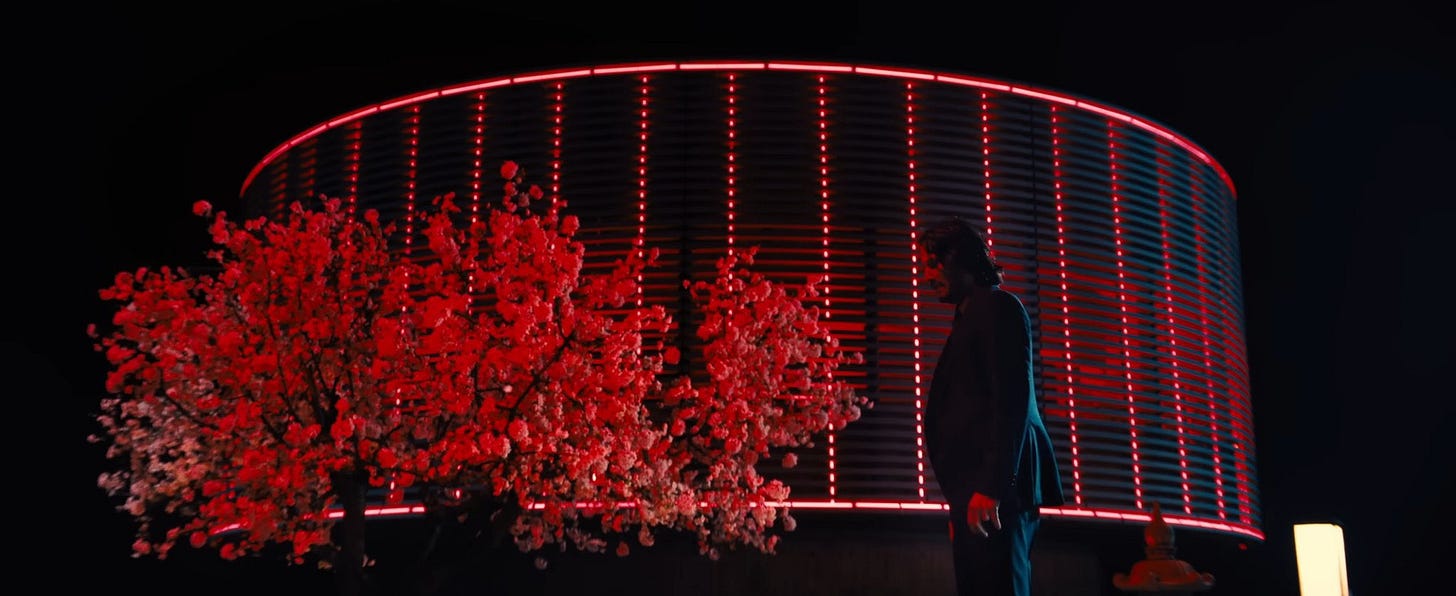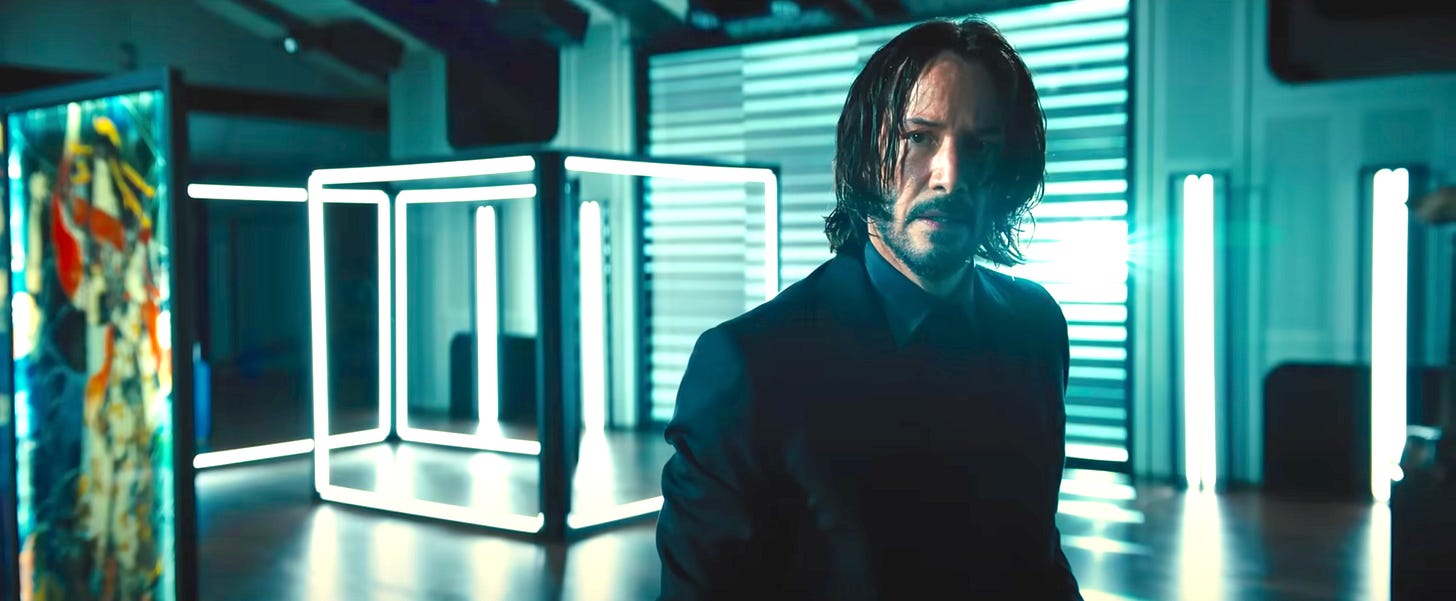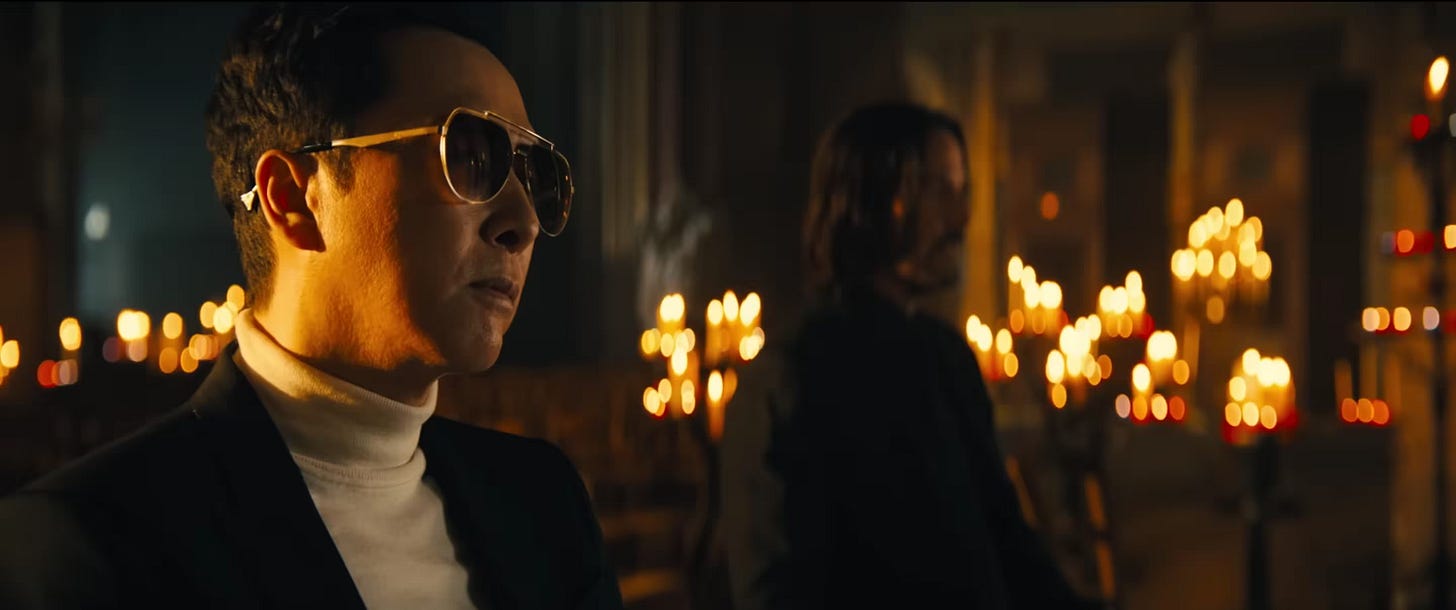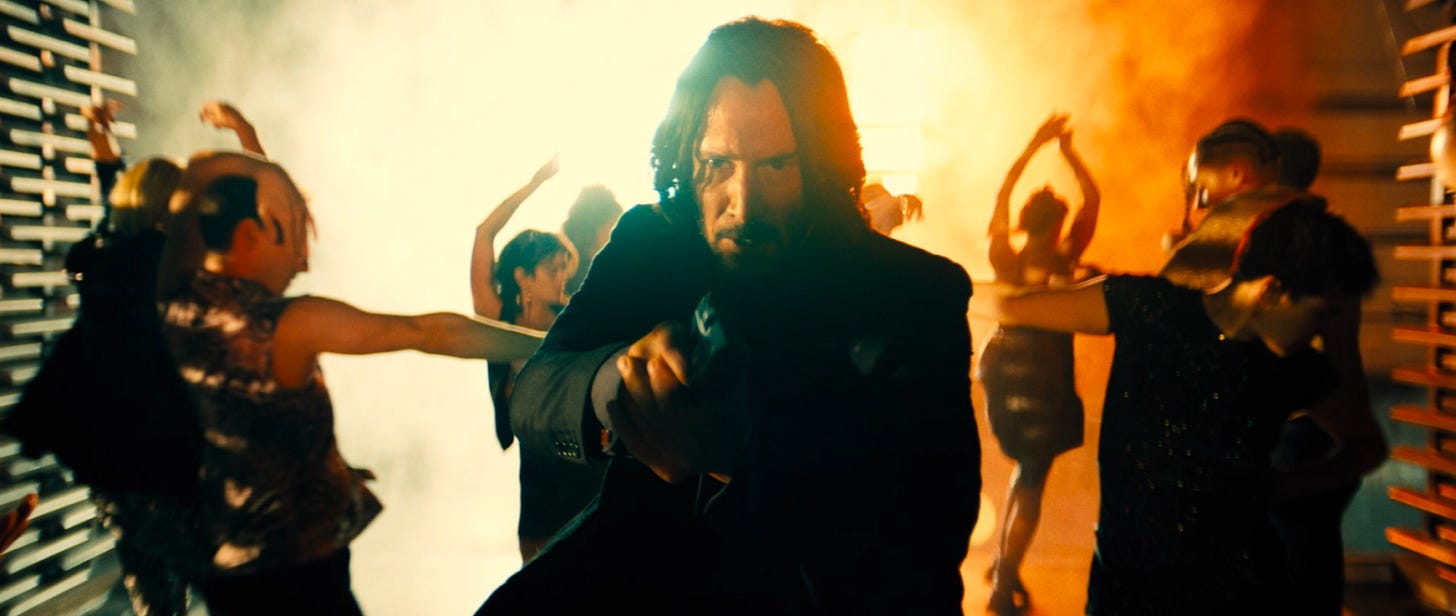In Motion #31 - John Wick: Chapter 4
Bodies in motion, the poetry of violence, the beauty of clichés, and Keanu.
Cherry blossoms are beautiful. I don’t think I’m alone in thinking that; in fact, I’m probably the opposite of alone. It is cliché to think cherry blossoms are beautiful? Would it matter if it was? I’m only asking because, over the past couple weeks, I’ve had more than one friend shame a personal choice of theirs for being too “cliché”, as if a gaggle of New Yorker critics and Twitter drones were about to jump out of the bushes and pounce on them for not being original enough with their lives. Is this what the modern world does to us, sapping us of earnestness even in our most private moments, convincing us that everything we do must be a hot take or else? I guess it’s done it to me to, because here I am feeling guilty about my fondness for cherry blossoms. But I love looking at cherry blossoms, I really do. I love how bright they are, how they shimmer in the wind without ever seeming weak. I love how out of place they look when I see them in California; they remind me of some far away place that might not even exist, but one I’ve seen a thousand times in my dreams. They seem ancient & timeless, existing above any petty problem I or anyone else have ever had.
I’ll get back to cherry blossoms in a bit.
On a seperate note, if I may: I have anxiety. It’s nothing too exciting, just a general sense of unease that likes to follow me around wherever I go. Half the time it’s just simmering in the background, like a stove on low. Sometimes it goes away altogether. Sometimes it doesn’t. Sometimes it starts flooding other emotions and sticking its nose in where it doesn’t belong, kicking up dirt in the wrong channels. The anxiety kick-starts the jealousy, which starts feeding into the anger, which starts circling back to the anxiety. It feels like there’s an overdeveloped air-horn in my brain, perfect for helping a grade-A student stay an grade-A student, that runs rampant anytime it isn’t given the most specific/consuming tasks to scream at. Is this how it actually works? No, but I might as well have some fun with it. I know it holds me back, lets my mind race down idiotic corridors, uselessly burns up time that I could spend doing any number of productive & worthwhile things. It doesn’t prevent me from living my life, loving my friends, doing my work. But anxiety is a part of my life, and I can’t really “tough guy” my way out of that fact as much as I’d like to.
One of the first things you learn in therapy is that cures don’t really exist, at least for most of the things that might trouble you upstairs. Instead we have coping mechanisms, which are both constant and elusive. Coping mechanisms are found anywhere (although preferably not at the bottom of a bottle), but can also be so personalized that they’re not prescribable. That part is up to you. They can range from menial tasks, to watching ASMR, to career choices, to painting, to playing 2K with one of your best friends and doing everything in your power to make their experience as miserable as possible (this last one seems really popular with fans of Mario Party). I’ve accumulated a number of coping mechanisms over the years, well before I even realized they were much more than just time-wasters. Lately it’s been writing this very newsletter, collecting my thoughts in a more organized manner then just letting by brain dance around while listening to Eagles. But for a long time it was watching action movies. Oh, the sweet catharsis of watching a hero kick ass in ways you could only dream. Nothing quite like it.
John Wick: Chapter 4 is the latest installment of the increasingly awesome neo-noir action franchise about the world’s most beloved, best dressed murder-machine. Keanu Reeves once again stars as the titular assassin, once again on the run from the overlords of his criminal underworld after, once again, pissing them off. Having killed the highly-respected “Elder” in an act of vengeance, Wick suddenly finds himself on the wrong side of an impossibly annoying witch hunter (Bill Skarsgård) determined to burn everything he’s ever touched and everybody he’s ever befriended (Ian McShane, Hiroyuki Sanada, the very recently departed Lance Reddick) in an effort to cleanse the criminal world of his penchant for breaking rules. And so, with seemingly every living able-bodied person capable of holding a gun on his trail, it’s time at last for Mr. Wick to return to the fold, to turn the screws loose and to show the rest of the cinematic action world how it’s done.
Hyperbole is hard to swerve around when it comes to both John Wick and the movies that center around him. I remember seeing the first film in theaters eight-and-a-half years ago (has it really been that long?) and walking away with a simple question: where have you been all my life, Jonathan? It felt like an amalgamation of every separate cool thing that had ever existed and ever will exist, but without every being anything but its own pure self. John Wick took itself seriously without getting mopey, had fun without winking, featured Willem Dafoe making health shakes and snapping sniper rifles together, and also employed the best action anybody had seen in an American film in, I don’t know, a decade? The Great Magazine Fight of 2004 had infected the entire genre with goobs of lazy choreography and headache-inducing shaky cams, scrambling an entire artform into a haze of blurs and whirrs. Stahelski and co-director David Leitch (Bullet Train) cleansed all of that with John, and in doing so they reminded audiences how thrilling it used to be to watch bodies flail about on the big screen. People seemed to like that.
And then there was, is and always shall be: Keanu. Has there ever been a more cathartic, more deserved, more instantly successful Hollywood comeback than Keanu’s? Has there ever been an iconic part more tailor-made for the actor that portrayed them? Every unique aspect of Reeves’ persona feels present in Wick. The killer stoic line-readings, the hunger for stuntwork, the quiet affability he brings to every conversation (good actors are good listeners, and Reeves spends a lot of these movies listening to his wonderful castmates). It takes a special kind of star to smoothly pivot from being (1) a cultured citizen of the world who can understands all languages and meld into any culture, to (2) the deadliest human being that ever walked or crawled, to (3) a heart-breakingly damaged meld of muscle & bone, stumbling away from car crashes and gunfights with his uniquely bow-legged shamble. I’ve talked about Reeves before on this newsletter, about his gut-busting grumpiness in Destination Wedding; there always seems to be more to say about him. Sometimes I fear (not really, but almost) that Keanu might become boring to write about. That the memes, the jokes and the collective knowledge of his niceness might turn Keanu into (here we go again) a cliché. A dreaded cliché. But nope. Interesting people are impossible to tire of, it turns out. Especially when you get to watch them kill people with nunchucks on an IMAX screen.
It is with great pleasure that I can say that John Wick: Chapter 4 might be the best John Wick film yet. I’m not sure how this is possible. It’s not easy being able to top Michael Nyqvist telling tales of deadly pencils, shootouts in mirrored hallways and a geeky Mark Dacascos swordfight in a room made entirely of glass. And to be fair, there aren’t too many things that Chapter 4 does that other films haven’t done before; clichés tend to breed like rabbits in the John Wick universe. But like the previous three films, it’s not about doing something new as much as it is about doing something well. So if you’re going to rip-off Zatoichi by having a blind warrior with a sword-equipped walking stick, you might as well cast Donnie Yen in the part. If you’re going to trot the globe like James Bond, you might as well photograph everything like a day-glo graphic novel. And if you’re going to once again have Keanu mow his way through another army of blood-thirsty mooks, you might as well give him a box of incendiary rounds to set each & every one of them en fuego. Stahelski’s armed with a $100 million budget this time around, $25 million more than that of Chapter 3. For the first time in a long time, it feels like somebody finally put every last cent in their pocket up on the screen.
Are miracles inevitable? Because Chapter 4 doesn’t feel like a sequel. It feels like an inevitability, as if all of the films before were simply stepping stones on a path towards it. And I don’t just mean every other John Wick film; I mean every other Western action movie. This feels like a peak. Hopefully not the peak, but a peak. You can feel Keanu climb it, sometimes literally; one notable set-piece has him staggering up an impossible long flight of stairs as he fights off endless hordes of enemies with everything at his disposal, at one point taking apart his empty handgun to stab someone with the disconnected metal. Metaphors and symbolism seem so easy with bloodshed this beautiful; the film reaches for literal baptism when Wick gets thrown down an indoor waterfall by German mobster Killa (Scott Adkins, having a lot of fun). The action slows to a graceful crawl as we watch our eternally damned hero stumble to his feet, the water soaking and washing away his pain as he charges himself up for round two. It’s fitting that the next film in this franchise is a spin-off called Ballerina; few American non-musical movies have relied so heavily on the beauty of choreography, on watching these selfless performers move in ways most never could. Sometimes there really is nothing better than the real thing.
If there’s one idea John Wick: Chapter 4 has down pat, it’s that cinematic violence can be more than mere blood & guts. It’s something the more puritanical audience members among us have never really been able to understand and probably never will. There is something unqiuely purifying about cinematic violence in a way that real violence never is. Real life violence is horrifying, traumatic, damaging; it has weight and cost. Some very good films have attempted to imitate that. Other films don’t, knowing their artiface gives them room for something else. Chapter 4 belongs to that second group. It laughs at the idea of reality by reveling in its unreality. I howled like a madman when Reeves, Stahelski and the 87Eleven stunt-team started using Paris’ Arc de Triomphe to play Frogger with real cars, and I howled again each time Wick used those incendiary rounds to light yet another body on fire. But I didn’t howl when Donnie Yen fought Hiroyuki Sanada, the two international legends uniting at last as former friends now fighting each other to protect their last remaining loved ones, possibly their only remaining tethers to a world that doesn’t look or feel like Hell. I might cry the next time I see this thing. Onscreen violence, a mixture of hard work and good acting, can be poetic. And just like poetry, it can be so much more than what appears on the surface.
There is a recurring motif in John Wick of violence going unnoticed in public spaces. Chapter 2 features the most famous instance of it, but both 1 & 4 pull this gag in a nightclub. Maybe those without any kind of social anxiety will find this goofy, but the image of a silent, lonely hero waltzing unnoticed into a club populated with younger, sexier couples and quietly being cooler than anybody else in the room…yeah. What I wouldn’t give to not worry about the people around me, safe in the confidence that I’m doing something they couldn’t. That’s the untouchability of Keanu, that transcendent cool most actors spend lifetimes trying to fake. When it’s palpable enough, like in these nightclub scenes, you almost feel like you can take some of it for yourself and wear it like armor. It’s an incredible image they milk over and over again in Chapter 4, weaponizing Keanu’s abnormality when compared to others. I suppose the appeal of John Wick has always been about catharsis, in the same way that sports & video games have always been crushing enemies without actually doing anything harmful. Chapter 4 loads more emotion onto that cartharsis than ever before. It does so through Keanu’s incredibly warm interactions with Yen & McShane & his old pal Laurence Fishburne, through the constant sad reminders that the best parts of John’s life are already buried in a cemetary, and through a final exchange between friends about the futility of living in fear of death. “Those who cling to death; live”, says one: “Those who cling to life; die” is the reply. Then they fire their guns at each other.
There’s a scene early in Chapter 4’s first act where John Wick sits down for some tea. It’s in Osaka, on the rooftop balcony of his friend’s hotel. Everything around them is bathed in a warm reddish glow. The conversation that ensues is deep enough to include the line “Friendship is meaningless when convenient” (I’ll have to remember that one), but the thing that struck me wasn’t the words. It wasn’t even the conversation. It was the image that occurs before Wick sits down, the image at the top of this page: standing with his back turned to the world, sharing the frame with an indescribably bright cherry blossom tree. At first I thought: cliché. Five minutes in Osaka and we’re already looking at a cherry blossom tree? Then the beauty of it started to pummel me. Beauty isn’t something you argue with. If you don’t find it, it’ll find you. It’ll come in, erase all doubt and replace it with certainty, the certainty that what you’re looking at is what everything in the world should look like, at least for a little while. Beautiful moments don’t last forever; good scenes always end, beautiful conversations always come to a close, and pretty faces will always turn to look at someone else. Not everybody gets to truly appreciate beauty; don’t feel guilty for being able to, even if it’s a cherry blossom tree in an action movie.
(John Wick: Chapter 4 is currently playing in theaters)







Expertly written, such a fantastic film.